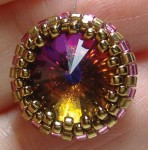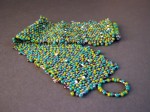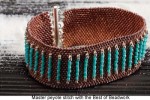Peyote Stitch Bead Patterns (2/25/2016)
What? You haven’t learned Peyote stitch yet? There’s no better time than now. I have several different beginner’s tutorials, so if one doesn’t make the lightbulb go off for you, try another. Everyone learns in different ways, so don’t give up if one tutorial doesn’t work for you.
http://www.aroundthebeadingtable.com/
The base for all of my rivoli patterns is the peyote bezel. Made up of size 11/0 Delica beads and 15/0 seed beads, this beaded bezel—or cup—holds the rivoli in place and also enables you to embellish the rivoli by beading around it.
http://www.silverhilldesign.com
Peyote stitch looks very much like brick stitch, only turned sideways. The way it is stitched, however, is quite different. The rows of beads wind up “staggered” so that each row nests into the rows above and below it. (You can see this in the two small sample patterns shown below.) Peyote is a vibrant, versatile stitch that can create an amazing soft “cloth” or beautiful stiff freestanding vessels depending upon how you work it up.
http://inspirationalbeading.blogspot.com/
One of the most important stitches that any beadweaver will learn is the versatile and endlessly useful peyote stitch. Also called gourd stitch, the seemingly simple pick-up-one-skip-one pattern can be one of the most frustrating to master. Although the basic concept is easy enough to understand, finding the right tension and making the beads go where they should takes a lot of practice.
Peyote stitch is a pattern used to weave beads together using a needle and thread. This is still used in many traditional cultures in Africa to make symbolic headdresses and jewelry. However, even those who are from other cultures can benefit from knowing how to do peyote stitch. Depending on the stitch technique that is used, the resulting woven pieces could be flat strips, tubes, or flat round shapes, and can be used to create bags, jewelry, images, and other decorative elements.
http://www.interweavestore.com/
Peyote stitch is used around the world, in many different cultures, for many different things. Examples of peyote stitch have been found among ancient Egyptian artifacts, but the name “peyote stitch” comes from the Native American bead-weaving tradition of using the stitch to decorate the handles of gourds used for Native American peyote ceremonies.
Odd count peyote stitch is exactly like even count peyote stitch, except when turning around to start a new row. On half of the rows, the hard turn requires a few extra steps, which involves weaving the thread a few beads in from the edge and then back to start a new row. On the other half of the rows, the easy turn is made the same way as in even count peyote stitch.





Comments are closed.